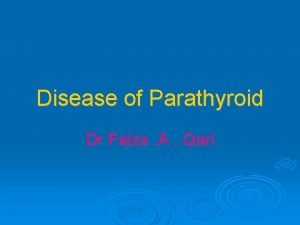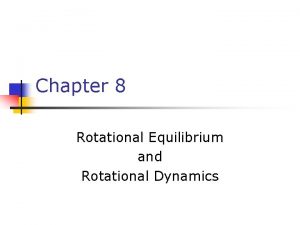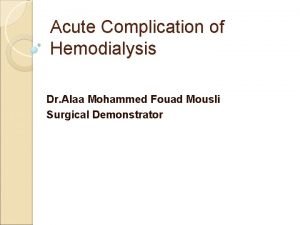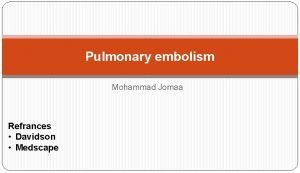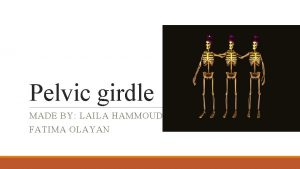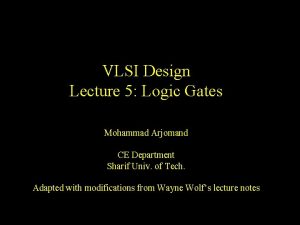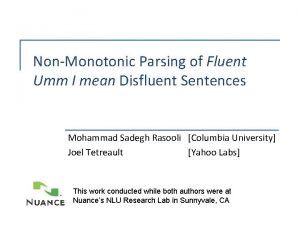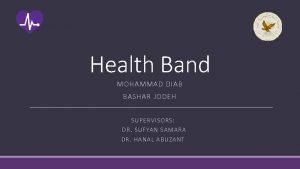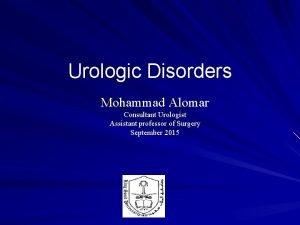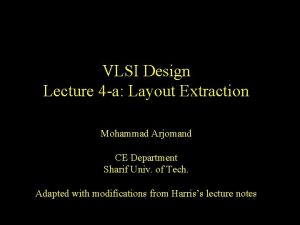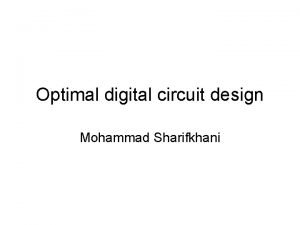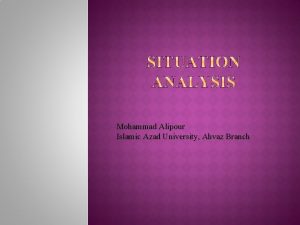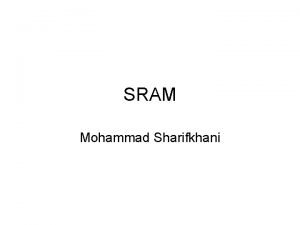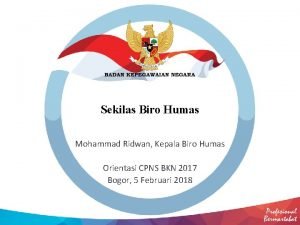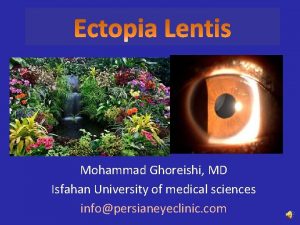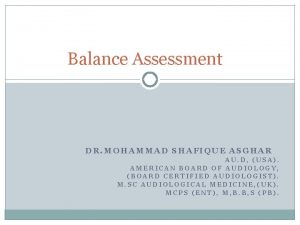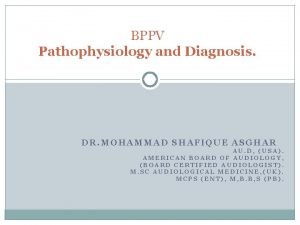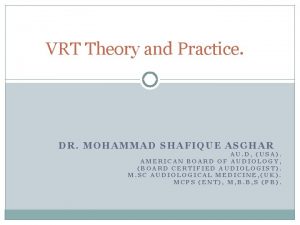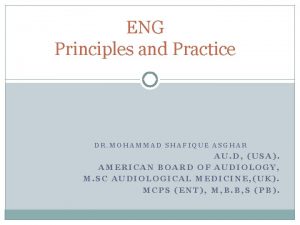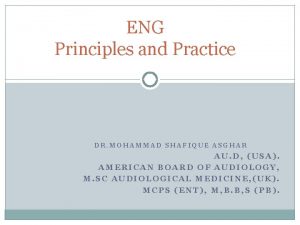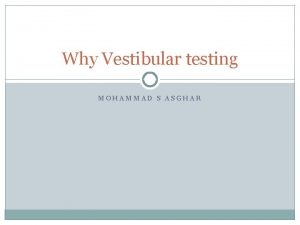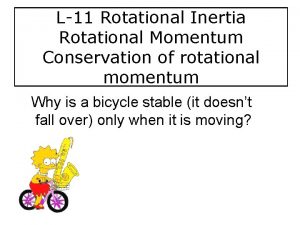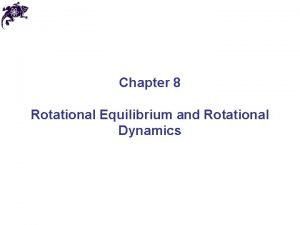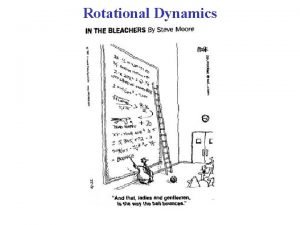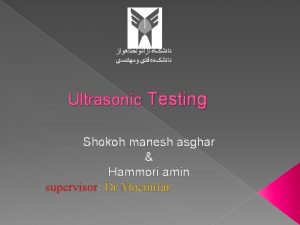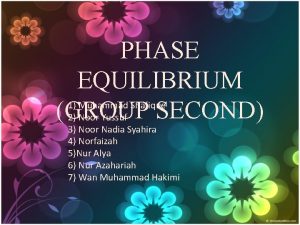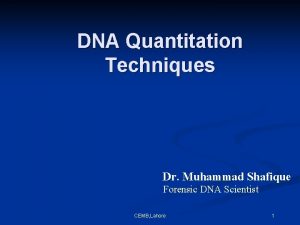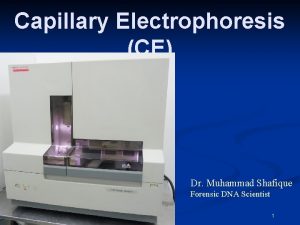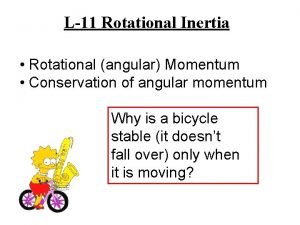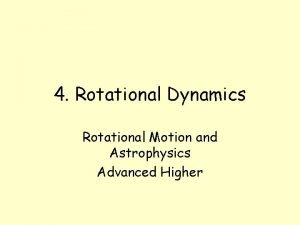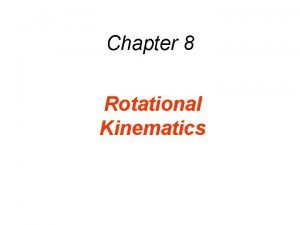Rotational testing DR MOHAMMAD SHAFIQUE ASGHAR AU D



































- Slides: 35

Rotational testing DR. MOHAMMAD SHAFIQUE ASGHAR AU. D, (USA). AMERICAN BOARD OF AUDIOLOGY(USA), M. SC AUDIOLOGICAL MEDICINE, (UK). MCPS (ENT), M, B. B, S (PB).

Introduction In vestibular testing we are always testing output of vestibular system. We do not have any direct clinical measurement. Even with Vest. Evoked responses we use an auditory signal and record a myogenic potential from the sacule response via Sternocledomastoid muscle. For ENG, Posturography and Rotary Chair tests we use VOR and VSR.

Principle underlying Rotational testing. VOR is the key for rotational testing.

Types of Rotational tests 1. Passive Rotational testing Patients whole body is rotated without any relative movement between the head and body. 2. Active Rotational Tests In this test patient rotates his/her head back and forth while the body remains stationary.

Passive Rotational tests These are classified according to the particular signal used 1. Velocity step test 2. Sinusoidal oscillation test.

Passive Rotation tests (cont). . In these tests the rotational axis is vertical and passes through the center of the head. Thus it only stimulate the Horizontal Semicircular Canal.

Rotational tests (cont). . Early Velocity step test. Barany was the first to describe the Velocity step in 1907. Patient was seated in a rotating chair, with his head tilted 30 degree forward. Patient manually rotated at approximately 180 degree/sec. Then the patient was stopped suddenly facing the examiner.

Early velocity step test (cont). . The nystagmus response generated was measured by a stop watch. Both clockwise and anticlockwise rotation responses were measured. Two features were noted. Strength and symmetry.

Modern Velocity Step test In modern rotational tests all the parameters of the test including stimulus generation, response measurement, and data analyses are controlled by computer.

Modern Rotatory test

Modern Velocity step test (cont)… Patient is seated with eyes open in the darkened room. Eye movements are recorded with surface electrodes and also observed with infrared video camera Velocity steps in both Rt and Lt direction are used.

Modern Velocity step test (cont)… Three parameters are measured 1. Gain 2. Phase 3. Asymmetry

Modern Velocity step test (cont)… Peripheral lesions cause hypofunction CNS lesions may cause hyperfunction

Modern Velocity step test (cont)… Advantages. Do not need much cooperation, Useful for children, infants and legal population. Disadvantages Only tests horizontal SCC. It is a low frequency test (below 1 KHz)

Sinusoidal Oscillation test Early Torsion swing test. Patient was seated on a chair with a calibrated spring The chair was calibrated to oscillate at the rate of. 05 Hz. The right beating and Lt beating response was measured and compared.

Modern Sinusoidal Oscillation test Slow harmonic acceleration test is the most widely used rotation test. Patient is tested with eyes open in a darkened room. Sinusoidal oscillations at vertical axis are provided at. 01, . 02, . 04, . 08, . 16, . 32 and. 64 Hz with peak angular velocity of 50 Degree/sec.

Modern Sinusoidal Oscillation test (cont)… Response Parameters. 1. Phase 2. Gain 3. Asymmetry

Active Rotation tests These are the tests in which the patient rotates his head actively while the body remains stationary. Like other rotational test this test also makes use of VOR.

Active Rotational tests Types of Autorotation Test 1. Vestibular autorotation test. 2. Active head shake test.

Advantages of autorotation tests Equipment is cheap and portable. It can assess all the physiological range of VOR (. 5 to 5 -6 Hz). High frequency test. It can also test vertical motion of the head, which is not possible with Passive rotation tests. Can be used for monitoring the effects of ototoxic drugs at bedside.

Disadvantages of VAT Needs patient’s cooperation. Some patients lack proper coordination and cannot do multitasks. They may not be willing to cooperate (Functional).

Vestibular Autorotation Test (VAT)

Vestibular Autorotation Test (VAT)

VAT Patient wears a headband upon which an accelerometer is attached for measuring head motion. (Vertical and Horizontal). Patient is instructed to fixate at a point in front of him. Patient shakes his head back and forth for 18 seconds in time with the ticks of a metronome.

VAT (cont)… The frequency changes from 0. 5 Hz to 0. 8 Hz during the first 6 seconds (calibration period) and from. 8 Hz to 6 Hz during last 13 seconds. The test is repeated in both directions, vertical and horizontal. The computer analyses the results as in passive rotation tests.

VAT (cont)… Response Parameters. 1. Gain 2. Phase 3. Symmetry

Active Head Shake test. (AHST) This is provocative test designed to evoke nystagmus response in patients with vestibular lesion.

AHST

AHST (cont)… Principle underlying AHST. This is based on velocity storage phenomenon And Edward’s second Law: Which states that excitation is stronger than inhibition.

AHST (cont). . Test protocol. Patient wears Frenzel’s glasses in a darkened room. He is instructed to shake his head vigorously back and forth for 20 seconds. Eye movements are recorded (observed) for nystagmus for 30 seconds.

AHST (cont). . Test results. In patients with peripheral vestibular lesion nystagmus with fast phase towards better ear. Bilateral lesion, normal and compensated UVD patients may not have any nystagmus. Early vestibular Schwnoma and Meniere's disease may show a nystagmus with fast phase towards affected ear. When it is +ve, it has a strong sensitivity.

Dynamic Visual Acuity test (DVA) Computer screen for DVA

DVA The Dynamic Visual Acuity (DVA) Test measures visual acuity during head motion. Comparisons between static and dynamic acuity at selected test frequencies can be quickly evaluated.

DVA (cont). . The DVA-Test is scored using the log Mean Angle Resolvable (log. MAR) scale that allows visual performance scores to be precisely quantified and statistically analyzed. The DVA-Test provides valuable information about the Visual Vestibular Ocular Reflex (VVOR) in well subjects (pilots, athletes) as well as in patients with vestibular deficits.

 Faiza asghar
Faiza asghar Dr faiza asghar death
Dr faiza asghar death Primary hyperparathyroidism
Primary hyperparathyroidism Are inert materials such as sand and gravel
Are inert materials such as sand and gravel Rotational equilibrium
Rotational equilibrium Rotational equilibrium and rotational dynamics
Rotational equilibrium and rotational dynamics Mohammad keshavarz
Mohammad keshavarz Mohammad ali javidian
Mohammad ali javidian Mohammad ali abtahi
Mohammad ali abtahi Phynetoin
Phynetoin Dr mohammad aman
Dr mohammad aman Mohammad davidson
Mohammad davidson Anovulation who classification
Anovulation who classification Pelvic girdle
Pelvic girdle Dr nur mohammad hadi zahalan
Dr nur mohammad hadi zahalan Mohammad irfan bowdoin
Mohammad irfan bowdoin Vlsi
Vlsi Dr mohammad aman
Dr mohammad aman Shaik mohammad tajuddin
Shaik mohammad tajuddin Mohammad sadegh rasooli
Mohammad sadegh rasooli Mohammad diab md
Mohammad diab md Mohammad alomar
Mohammad alomar Mohammad moshtari
Mohammad moshtari Sumbangan mohammad eunos abdullah sejarah
Sumbangan mohammad eunos abdullah sejarah Mohammad arjomand
Mohammad arjomand Mohammad sharifkhani
Mohammad sharifkhani Mohammad sharifkhani
Mohammad sharifkhani Mohammad alipour
Mohammad alipour My.edu.sharif
My.edu.sharif Mohammad sharifkhani
Mohammad sharifkhani Dr mohammad khan
Dr mohammad khan Mohammad ridwan bkn
Mohammad ridwan bkn Mohammad ghoreishi
Mohammad ghoreishi Metode black box
Metode black box Rigorous testing in software testing
Rigorous testing in software testing Cs3250
Cs3250


